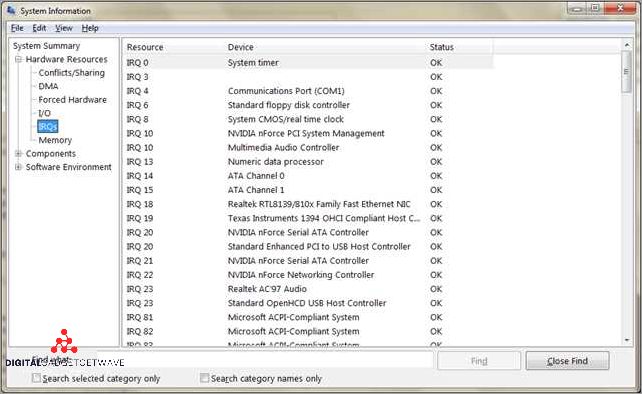
An IRQ, also known as an Interrupt Request, is a mechanism used by computer systems to handle both hardware and software events that require the immediate attention of the processor. It is a crucial component of the system’s interrupt handling mechanism, allowing devices and system resources to communicate with the CPU efficiently.
When a device or system resource needs attention from the CPU, it sends an interrupt request, or IRQ, through the system bus. This request signals the CPU to temporarily pause its current processing and switch its attention to the requesting device or resource. The CPU then invokes an interrupt handler, which is a small piece of software that is responsible for processing the interrupt and determining the appropriate action(s) to take.
IRQs play a vital role in determining the priority of interrupts in a system. Each interrupt request has a unique priority level, which determines the order in which they are processed by the CPU. Higher priority interrupts are typically processed before lower priority ones, ensuring that critical events are dealt with promptly.
The operating system, specifically its kernel, manages the assignment of interrupt handlers to the various interrupt requests. When a device driver is installed, it registers its interrupt handler with the kernel, allowing it to receive and process interrupts from the associated device. The interrupt handler is responsible for performing necessary tasks, such as reading input from the device or providing output to the device.
One important consideration when dealing with interrupts is interrupt latency. Interrupt latency refers to the time delay between when an interrupt occurs and when it is processed by the CPU. Minimizing interrupt latency is crucial in real-time systems, where timely processing of interrupts is critical. Various factors, such as the CPU’s processing speed, interrupt controller efficiency, and the prioritization of interrupts, can affect interrupt latency.
In summary, an IRQ is a mechanism that allows devices and system resources to communicate with the CPU, requiring immediate attention. It involves the use of interrupt requests, interrupt handlers, and interrupt priority to efficiently handle hardware and software events. Understanding IRQs and their operation is essential for optimizing system performance and ensuring the timely processing of critical events.
Contents
- 1 What is an IRQ and How Does it Work Explained
- 2 Understanding IRQ
- 3 IRQ Mechanism
- 4 IRQ Usage
- 5 Evolution of IRQ
- 6 FAQ about topic “Demystifying IRQs: Understanding their Functionality and Operation”
- 7 What is an IRQ?
- 8 How does an IRQ work?
- 9 What devices use IRQs?
- 10 Can IRQs conflict with each other?
- 11 How are IRQs assigned to devices?
What is an IRQ and How Does it Work Explained
An IRQ (Interrupt Request) is a signal sent by a device to the CPU (Central Processing Unit) to request attention for processing. It is a fundamental concept in computer systems that allows devices to communicate with the CPU and ensures proper functioning of the system.
When a device, such as a keyboard or mouse, needs to send data or interact with the CPU, it generates an interrupt request. The CPU then receives this interrupt request and temporarily suspends its current task to handle the request. This allows the device to communicate with the CPU without causing latency or delays in processing other tasks.
The priority of the interrupt requests is managed by the kernel of the operating system. The kernel assigns a priority level to each device and determines the order in which the interrupt requests are processed. This ensures that critical operations are handled first, while less important tasks may be delayed.
Each device connected to the system has a unique IRQ assigned to it, which allows the CPU to identify and process the interrupt requests from different devices. The IRQ controller, also known as the interrupt controller, is responsible for managing the assignment and processing of these IRQs.
Device drivers play a crucial role in handling IRQs. A device driver is a software component that allows the operating system to communicate with the hardware device. It includes an interrupt handler, which is a piece of code that responds to the interrupt request generated by the device. The interrupt handler is responsible for processing the input or output operation requested by the device.
In summary, an IRQ is a mechanism that enables devices to communicate with the CPU in a system. It allows for efficient processing of different tasks without causing latency or delays. The kernel manages the priority of the interrupt requests, and device drivers handle the processing of these requests through interrupt handlers. The IRQ controller plays a crucial role in managing and assigning IRQs to different devices.
Understanding IRQ
IRQ stands for “Interrupt Request” and is a fundamental aspect of how a computer’s hardware and software interact. An interrupt is a signal sent by a device to the CPU to gain its attention and interrupt its current processing. It is a way for the hardware to communicate with the software and vice versa.
The CPU is constantly processing instructions, but it needs to be able to handle events that are not predictable or occurring in real-time. This is where interrupts come in. When a device wants to communicate with the CPU, it sends an interrupt signal through a bus. The CPU interrupts its current processing and jumps to an interrupt handler.
The interrupt handler is a piece of software that is responsible for handling the interrupt. It determines the priority of the interrupt and performs the necessary actions. The handler may communicate with the device or perform other tasks, such as updating system data or triggering an output.
Each interrupt has a unique number associated with it, known as its IRQ number. The operating system keeps track of these numbers and assigns them to different devices and their respective interrupt handlers. This allows for efficient management of the interrupts and prevents conflicts.
IRQs can be shared between devices, meaning that multiple devices can use the same interrupt number. However, since the CPU can only handle one interrupt at a time, interrupt handlers must be designed to handle shared interrupts properly and prevent data corruption or loss.
Latency is an important factor to consider when it comes to interrupts. Latency refers to the time delay between when an interrupt is triggered and when it is actually handled by the interrupt handler. Minimizing latency is crucial for real-time systems or time-sensitive tasks.
The kernel of an operating system plays a crucial role in managing interrupts. It is responsible for handling the routing of interrupts to their respective interrupt handlers and ensuring that they are handled in a timely and efficient manner. Kernel-level drivers are also responsible for interacting with devices and managing their interrupt requests.
In conclusion, IRQs are an essential part of the interaction between hardware and software in a computer system. They allow devices to communicate with the CPU and interrupt its processing when necessary. Proper management and handling of IRQs are key to ensuring the smooth operation of a computer system.
The Purpose of IRQ
The purpose of IRQ (Interrupt Request) is to facilitate communication and coordination between hardware devices and the CPU in a computer system.
When a hardware device needs the attention of the CPU, it sends an interrupt request (IRQ) to the CPU. This request is a signal that interrupts the normal processing of the CPU and alerts it to handle the request.
In order for the CPU to handle the interrupt request, it uses an interrupt handler, which is a software driver that is responsible for processing the interrupt. The interrupt handler is part of the kernel of the operating system and is executed when an interrupt occurs.
Each hardware device is assigned a specific IRQ line, allowing it to send interrupt requests to the CPU. The IRQ lines are controlled by the interrupt controller, a hardware component that manages the flow of interrupt requests. The interrupt controller determines the priority of each request and directs them to the CPU accordingly.
When an interrupt request is received, the CPU suspends its current tasks and begins executing the interrupt handler for the corresponding hardware device. The interrupt handler performs the necessary processing or tasks required by the device and then resumes the normal operation of the CPU.
The purpose of using IRQs is to offload certain processing tasks from the CPU, allowing the hardware devices to handle their input and output tasks more efficiently. By using interrupts, the CPU can prioritize and respond to requests from multiple devices in a timely manner.
Since IRQ lines are shared among multiple devices, there may be cases where multiple devices send interrupt requests at the same time. In such cases, the interrupt controller manages the priority of the requests and determines which request should be processed first based on the assigned priorities.
IRQs also help reduce latency in a system by allowing hardware devices to directly request the attention of the CPU instead of relying on the CPU to periodically check for device status. This improves the overall responsiveness of the system and enhances its performance.
In conclusion, the purpose of IRQs is to enable efficient communication between hardware devices and the CPU in a computer system. By using interrupts, the CPU can handle requests from devices in a timely manner, offloading certain processing tasks and improving the overall performance of the system.
IRQ Mechanism
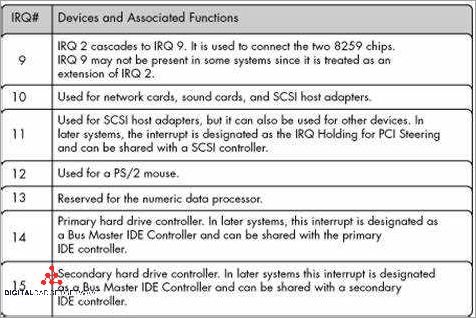
The IRQ (Interrupt Request) mechanism is a crucial part of a system’s hardware and software integration. It allows communication between different devices and the central processing unit (CPU) by interrupting the CPU’s normal processing flow.
Each device connected to the system has its own dedicated IRQ line, which it can use to send an interrupt request to the CPU. This request signals that the device needs immediate attention or wants to notify the CPU about a specific event, such as an input or output operation.
IRQs are often shared among multiple devices to minimize hardware complexity, as there is a limited number of available IRQ lines. When multiple devices share an IRQ line, they must take turns using it. This sharing is coordinated by an interrupt controller, which is usually part of the system’s chipset.
When an interrupt request is received on an IRQ line, the interrupt controller notifies the CPU. The CPU then suspends its current processing and transfers control to an interrupt handler. The interrupt handler is a small piece of software, usually part of the kernel or a device driver, that is responsible for processing the interrupt.
Each interrupt has a priority associated with it, indicating its relative importance. The CPU follows a priority scheme to determine which interrupt to handle first when multiple interrupts occur simultaneously. This priority scheme ensures that critical events are promptly processed, while non-critical events may experience some latency.
The interrupt handler, once activated, performs the necessary processing for the specific event that triggered the interrupt. This processing may involve reading data from an input device, writing data to an output device, or executing some other predefined action.
Once the interrupt processing is complete, the CPU returns to its previous state and resumes executing the interrupted program.
How IRQ Works on a Computer
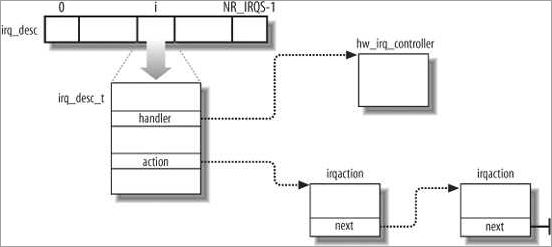
An IRQ, or Interrupt Request, is a mechanism used by a computer to handle hardware interrupts. It allows external devices to communicate with the CPU and request its attention. When a device needs to send or receive data, it sends an interrupt request to the CPU, which stops executing its current task and handles the interrupt.
IRQs are shared among different devices on a computer system. Each device is assigned a specific IRQ number, which determines its priority. When a device sends an interrupt request, it is processed based on its assigned priority. Higher-priority interrupts are serviced first, while lower-priority interrupts may have to wait in the queue.
The IRQ controller is responsible for managing and distributing interrupt requests to the CPU. It receives interrupt signals from various hardware devices and forwards them to the CPU for processing. The controller keeps track of the pending interrupts and their priorities, ensuring that the CPU handles them in the correct order.
Device drivers play a crucial role in IRQ handling. A device driver is a software component that allows the operating system kernel to communicate with a specific hardware device. It configures the device’s IRQ settings and handles interrupt requests from the device. The driver receives the interrupt signal, processes the data, and passes it to the appropriate software component in the system.
IRQs can be categorized into two types: input and output interrupts. Input interrupts occur when a device needs the CPU’s attention to receive data, while output interrupts happen when a device needs to send data. The CPU switches between these interrupts based on the needs of the devices and the operating system’s scheduling algorithm.
Latency is an important factor in IRQ handling. Latency refers to the delay between the occurrence of an interrupt request and the CPU’s response. A low-latency IRQ system ensures that interrupts are serviced quickly, reducing the delay in processing critical tasks and improving overall system performance.
In conclusion, IRQs play a crucial role in computer systems by allowing hardware devices to communicate with the CPU. They are managed by the IRQ controller and prioritized based on their assigned IRQ numbers. Device drivers handle the interrupt requests from specific devices, ensuring efficient communication between hardware and software components. The proper management of IRQs is essential for the smooth operation of a computer system.
Types of IRQ Connections
An IRQ (Interrupt Request) connection is a mechanism used to interrupt the normal processing of a CPU in response to a specific event or request. There are different types of IRQ connections, each serving a specific purpose in the system.
1. Hardware IRQ: These interrupts are generated by physical devices or hardware components such as keyboards, mice, network cards, or hard drives. Each hardware device is assigned a specific IRQ line, and when an event occurs, the device sends an interrupt request to the CPU.
2. Shared IRQ: In some cases, multiple devices may share the same IRQ line. This is called a shared IRQ. The operating system’s kernel manages the shared IRQs and ensures that each device receives the necessary attention when interrupt requests are received.
3. Software IRQ: Apart from hardware interrupts, software can also generate interrupts. These software-generated interrupts are typically used by device drivers to communicate with the system. For example, an input device driver may generate an interrupt when a key is pressed, signaling the system to process the input.
4. Priority IRQ: Each IRQ has a priority level assigned to it. When multiple interrupts occur simultaneously, the CPU prioritizes them based on their assigned priority levels. This ensures that the most critical interrupts are processed first, improving the overall system performance and responsiveness.
5. Kernel vs. User Space: IRQ connections can occur in the kernel space or user space of an operating system. Kernel-space interrupts have direct access to system resources and can execute privileged instructions. User-space interrupts, on the other hand, rely on kernel services and have limited access to system resources.
Overall, IRQ connections play a crucial role in managing the flow of data and events in a computer system. The interrupt handler, also known as the IRQ handler, is responsible for processing the interrupt requests and directing the system’s resources accordingly. Minimizing interrupt latency and optimizing the handling of IRQs is essential for maintaining efficient system performance.
IRQ Usage
IRQ (Interrupt Request) is a vital aspect of hardware and software interaction in a computer system. It is the mechanism by which hardware devices can request the attention of the CPU. IRQs are used to manage the flow of information between hardware devices and the CPU, allowing for efficient processing of input and output operations.
Every hardware device that needs to send an interrupt signal to the CPU has an associated IRQ line. When a device needs to send a request to the CPU, it asserts its corresponding IRQ line, signaling that it requires attention. This request is processed by an interrupt controller, a hardware component responsible for managing all the IRQ lines in the system.
The interrupt controller acts as a middleman between the hardware devices and the CPU. It receives the interrupt request from a device and decides on the priority of the interrupt. The priority determines the order in which the interrupts are processed by the CPU. Higher priority interrupts are processed first, ensuring timely handling of critical tasks.
The interrupt handler is the software component that receives and processes the interrupt request from the interrupt controller. When an interrupt occurs, the current state of the CPU is saved, and the appropriate interrupt handler is executed. The interrupt handler performs the necessary actions to handle the interrupt, such as reading data from a device, writing data to a device, or performing other processing tasks.
IRQs can be shared among multiple devices, meaning that several devices can use the same interrupt line. This is done to optimize the usage of available IRQ lines and reduce hardware costs. In such cases, each device connected to the shared IRQ line has to be programmed with a unique identifier so that the interrupt handler can determine the source of the interrupt.
The kernel of the operating system plays a crucial role in managing IRQs. It provides the necessary software infrastructure for handling interrupts, including the interrupt handlers and the drivers required for each device. The kernel ensures proper allocation of IRQs, assigns priorities to interrupts, and coordinates the processing of interrupt requests.
IRQ Allocation by the Operating System
When a computer system receives an interrupt request (IRQ) from a hardware device, the operating system (OS) is responsible for allocating and managing the available IRQs. An IRQ is a signal sent by a hardware device to the CPU, indicating that it requires immediate attention or processing.
When a hardware device generates an interrupt request, it sends a signal to the Interrupt Controller, which is a hardware component responsible for managing and distributing these requests. The CPU, with the help of the kernel and device drivers, then identifies the source of the interrupt and executes the appropriate interrupt handler.
The operating system assigns each hardware device a unique IRQ, which helps in efficient management of interrupts. Each interrupt request is associated with a specific hardware component or device, such as a network adapter, sound card, or USB controller. The OS ensures that these devices do not conflict with each other and that they are given an appropriate amount of processing time.
In some cases, multiple devices may share the same IRQ. This is known as IRQ sharing and is implemented to save system resources. However, it can also introduce latency and slower processing times, as the CPU needs to prioritize and handle multiple interrupt requests simultaneously.
The OS uses a combination of software and hardware techniques to allocate the IRQs. The IRQ allocation process involves configuring the system’s BIOS settings, device drivers, and interrupt controllers to ensure efficient and reliable interrupt handling. Additionally, the OS may use Interrupt Request Line (IRQ line) arbitration methods to resolve conflicts and ensure that each device receives its required interrupt bandwidth.
In conclusion, IRQ allocation by the operating system plays a crucial role in managing and coordinating the interrupt requests generated by various hardware devices. By properly assigning and managing the available IRQs, the OS ensures that devices receive the necessary attention from the CPU and that interrupt handling is performed efficiently and without conflicts.
Conflicts and Troubleshooting with IRQ
When it comes to managing interrupts, conflicts can arise within the system. An interrupt request (IRQ) is a mechanism used by hardware devices to signal the CPU that they require immediate attention. However, when multiple devices share the same IRQ, conflicts can occur.
One common issue is IRQ sharing, where two or more devices share the same interrupt line. This can result in latency and performance issues, as the shared IRQ may not be able to handle all the requests simultaneously. In some cases, this can lead to dropped or missed interrupts, causing malfunctions or errors in the system.
To troubleshoot IRQ conflicts, the kernel and device drivers play a crucial role. The kernel is responsible for managing interrupts and ensuring that each device receives the necessary attention. Device drivers, on the other hand, facilitate communication between the hardware device and the operating system.
One way to resolve IRQ conflicts is by reassigning the interrupt request of a device. This can be done through software, where the device driver or operating system can allocate a different IRQ to the conflicting device. However, this solution requires careful consideration and analysis of the system’s hardware and software requirements.
Priority handling is another method used to troubleshoot IRQ conflicts. By assigning a priority level to each interrupt request, the system can determine which requests should be processed first. The interrupt handler, a software routine responsible for processing interrupts, can then prioritize the requests based on their assigned levels.
In some cases, conflicts can also arise from faulty hardware or outdated device drivers. Hardware issues, such as defective controllers or improperly installed devices, can cause IRQ conflicts. Updating device drivers to the latest version can help resolve compatibility issues and improve the overall stability of the system.
In conclusion, understanding and troubleshooting IRQ conflicts is essential for maintaining a stable and efficient system. By properly allocating interrupt requests, prioritizing handling, and ensuring up-to-date software and hardware, conflicts can be minimized, and the system’s performance can be optimized.
Evolution of IRQ
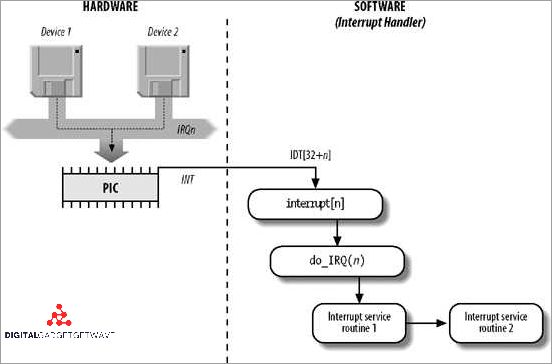
In computing, an interrupt request (IRQ) is a signal sent to the processor by a device or a software driver to request attention or to notify an event that requires immediate processing. The evolution of IRQs has played a crucial role in the development of computer systems and has greatly improved their performance and efficiency.
In the early days of computing, each device would have its own dedicated IRQ line, connecting directly to the CPU. This meant that each device could interrupt the CPU independently and without any coordination. As the number of devices increased, so did the number of IRQs, which led to a complex and inefficient system.
To address this issue, the concept of shared interrupts was introduced. Instead of each device having its own dedicated IRQ line, multiple devices would share the same line. This reduced the number of IRQ lines needed and allowed for more efficient resource allocation. However, it also introduced the need for priority handling in order to determine which device would be serviced first.
With the advent of bus architectures, such as the PCI bus, IRQs became associated with specific slots on the bus. This allowed for easier identification and management of devices. Additionally, the introduction of device drivers, which are software components responsible for interacting with specific devices, further improved the handling of IRQs.
In modern systems, IRQs are managed by a hardware controller that is connected to the CPU. This controller is responsible for receiving interrupt requests from devices, prioritizing them based on their urgency, and sending them to the CPU for processing. The CPU, in turn, has an interrupt handler in the kernel that is responsible for handling the interrupt request and executing the appropriate software routine.
IRQ management has also evolved to minimize latency, which is the time it takes for an interrupt request to be handled. Techniques such as interrupt coalescing and interrupt affinity have been introduced to optimize the processing of interrupts and reduce overall system latency.
In conclusion, the evolution of IRQs has been driven by the need to effectively manage and prioritize device interrupts in order to improve system performance and efficiency. The development of shared interrupts, bus architectures, device drivers, and hardware controllers has greatly contributed to the evolution of IRQs and their role in modern computer systems.
Changes in IRQ Handling Over the Years
IRQ (Interrupt Request) handling has undergone several changes over the years to improve the efficiency and performance of computer systems. In the early days of computing, IRQ handling was relatively simple and straightforward. Each device connected to the system had a unique IRQ that determined its priority in receiving service from the CPU.
As computer systems became more complex, the need for a more advanced IRQ handling system became apparent. The introduction of multitasking operating systems, such as the Windows and Linux kernels, required a more sophisticated approach to handle multiple devices and software concurrently requesting IRQs.
One significant change in IRQ handling was the introduction of driver-based IRQ handling. Instead of having each device handle its own IRQ requests, a software component known as a device driver was introduced. This driver would manage all the IRQ requests from the device and communicate them to the kernel, which would then prioritize and process them accordingly.
Another change was the implementation of shared IRQs. With the increasing number of devices being connected to a system, there was a limited number of available IRQs. To address this limitation, shared IRQs were introduced, allowing multiple devices to share the same IRQ. The software and hardware would then need to handle the conflicts that may arise from shared IRQs.
Furthermore, advancements in hardware and software technologies have also improved IRQ handling. Modern CPUs now have dedicated interrupt controllers, which efficiently manage and process IRQs. Additionally, software optimizations, such as interrupt coalescing and interrupt moderation, reduce the latency and processing overhead associated with handling IRQs.
In summary, IRQ handling has evolved significantly over the years to accommodate the changing needs of computer systems. The introduction of driver-based handling, shared IRQs, and advancements in hardware and software technologies have all contributed to improving the efficiency and performance of IRQ processing, reducing latency, and enhancing the overall system functionality.
Modern Alternatives to IRQ
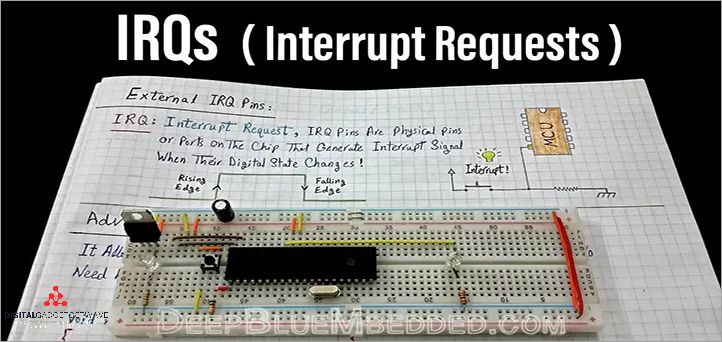
In modern computer systems, the kernel has implemented various alternatives to IRQs to manage hardware interrupts more efficiently. These alternatives provide improved performance and flexibility compared to traditional IRQs.
One such alternative is the use of request threads. Instead of assigning a fixed priority to each interrupt request (IRQ), the kernel dynamically schedules request threads based on the priority of the device generating the interrupt. This allows for better handling of interrupt requests, especially in scenarios where multiple devices are generating interrupts simultaneously.
Another alternative is the use of interrupt-driven drivers. While traditional IRQs require the CPU to handle all the processing related to the interrupt, interrupt-driven drivers offload most of the processing to the device’s own controller or handler. This reduces the CPU load and improves the overall performance of the system.
Kernel-level support for shared interrupts is also an important feature in modern systems. Instead of assigning a dedicated IRQ to each device, multiple devices can share a single IRQ. This is achieved by using advanced software and hardware techniques to ensure that each device is alerted only when its specific interrupt occurs, reducing latency and improving the system’s overall efficiency.
Furthermore, modern systems often employ interrupt input/output (I/O) coalescing techniques. This involves grouping multiple interrupt requests within a certain time frame into a single interrupt, reducing the number of interrupt requests and improving the system’s response time.
Overall, these modern alternatives to IRQs ensure that the handling of hardware interrupts is optimized, taking advantage of both hardware and software advancements to maximize system performance and efficiency.
FAQ about topic “Demystifying IRQs: Understanding their Functionality and Operation”
What is an IRQ?
An IRQ (Interrupt Request) is a signal that is sent to the CPU (Central Processing Unit) to inform it that a device needs attention or wants to communicate with it.
How does an IRQ work?
When a device wants to send an interrupt signal to the CPU, it will assert its assigned IRQ line, which is a dedicated electrical connection. The CPU will then interrupt its current task and handle the request from the device.
What devices use IRQs?
Almost all hardware devices in a computer system use IRQs to communicate with the CPU. Some examples include the keyboard, mouse, network card, sound card, and USB controllers.
Can IRQs conflict with each other?
Yes, IRQ conflicts can occur when two or more devices attempt to use the same IRQ line. This can result in device malfunctions or system instability. To resolve conflicts, IRQs can be manually assigned to different devices.
How are IRQs assigned to devices?
IRQs are usually assigned by the computer’s operating system during the boot process. The BIOS or UEFI firmware may also play a role in determining the initial IRQ assignments. In some cases, IRQs can be manually configured in the system’s BIOS settings.


